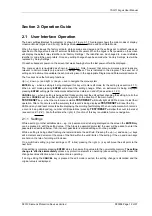
7SG11 Argus User Manual
©2013 Siemens Protection Devices Limited
P20006 Page 25 of 37
The sequence provided by the Argus in response to a permanent fault should be checked to ensure that the
programmed sequence is as given for a Phase Fault and is also applicable to Earth Fault and/or Sensitive Earth
Fault.
If the scheme requires the Argus to provide Auto Reclose initiated by a Status input then the SA Sequence should
be checked. The response to a Transient fault should be checked.
Record the results of the sequence test in Table 4-17.
4.2.5 Status Inputs
The operation of the status input(s) can be monitored on the ‘Status Input’ display shown in ‘Instruments Mode’.
Inject the required supply voltage into each status input and check for correct operation. Depending on the
application, each status input may be programmed to perform a specific function; each status should be checked
to prove that its mapping and functionality is as set.
Where the pick-up and/or drop-off timers associated with a status input are set to user scheme required delays
these delays should be checked either as part of the scheme logic or individually. To check a status pick-up time
delay, temporarily map the status to an output relay that has a normally open contact. Use an external timer and
time the interval between status energisation and closure of the output contacts.
To measure the drop-off delay, map to an output relay that has a normally closed contact, time the interval
between status de-energisation and closure of the output contacts.
Note.
The time measured will include an additional delay, typically less than 20ms, due to the response time of
the status input and the operate time of the output relay.
4.2.6 Output Relays
A minimum of five output relays is provided. Three of these have change over contacts; the remainder have
normally open contacts. Each contact can be tested individually by the trip test feature, which causes each output
relay to be pulsed for the user-programmable minimum dwell time, or they can be checked during commissioning
by testing the feature to which they are assigned.
Note.
A quick method of energising an output relay permanently, so that wiring can be checked, is to temporarily
map the output relay being tested to the ‘Protection Healthy’ signal – as this is permanently energised the
mapped relay will be held energised and normally open contacts will be closed. Remember to deselect the output
relays from the ‘Protection Healthy’ signal following the test.
4.2.7 Primary Injection Tests
Primary injection tests are essential to check the ratio and polarity of the transformers as well as the secondary
wiring.
4.2.7.1 Primary Current Tests
Use the circuit shown in Figure 4-6 to check the current transformer ratio and the C.T. connections for phase to
earth fault current. Inject a current of sufficient magnitude for the Argus relay ammeters to display. These levels
should be compared with the ammeters connected in series with the Argus. The secondary current is:-
ratio
CT
current
Primary
=
Is
Use the circuit shown in Figure 4-7 to check the current transformer ratio and the C.T. connections for phase to
phase fault. Record the results in Table 4-18.
4.2.7.2 Primary Directional Tests
This applies to Argus 2 and Argus 6 relays only
General
If the Argus being commissioned is directional then the voltage circuits should be tested to ensure correct polarity.
It is recommended that the Argus be connected to the C.T.’s and V.T.’s with the polarity as shown in the
Diagrams and Parameters section of this manual.
With the polarity connections shown, Argus relays will indicate ‘FORWARD’ direction of current when power is
flowing away from the switchboard busbar and ‘REVERSE’ when flowing into the busbar.
For an outgoing feeder, ‘FORWARD’ is the normal direction of power flow and for an incoming circuit,
‘FORWARD’ is opposite to the normal direction of power. However, normal application of directional protection is
















































